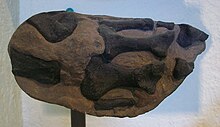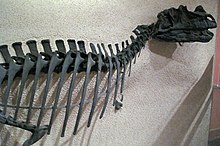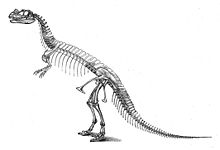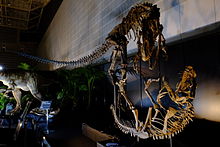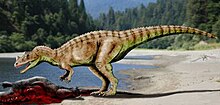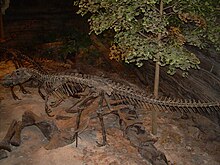Ceratosaurus
Ceratosaurus (Gr. "horned reptile") is an extinct genus with three species of ceratosaurid theropod dinosaur, which lived in the late period Jurassic, approximately 153 and 148 million years ago, in the Kimmeridgian and Tithonian, in what is now North America, Africa, Uruguay, and Europe. The type species, Ceratosaurus nasicornis is known primarily from five fragmentary skeletons including skulls which have been found in the Morrison Formation of the western United States. Ceratosaurus was one of the first dinosaurs discovered and the fourth theropod to be discovered, for which its classification was somewhat difficult, for this reason it was the type member of the infraorder Ceratosauria which bears its name. Fossils assigned to the species Ceratosaurus nasicornis have also been found in the Lourinhã Formation in Portugal and possibly in the Tendaguru Formation in Tanzania. Two species, of the many ever named, are still considered dubious, Ceratosaurus roechlingi from Tanzania and Ceratosaurus meriani from Switzerland
Description
Ceratosaurus followed the typical body plan of large theropod dinosaurs. It was bipedal and moved on powerful hind legs, while its arms were reduced in size. Ceratosaurus is characterized by having in its skull a horn-like structure on the dorsal part of the head, placed behind the nostrils. Ceratosaurus had a fused sacral bone with the synsacral bone, while the pelvic bones were held together. Unique among most theropods, Ceratosaurus possessed dermal armor, with small osteoderms located in the middle of the back. Its tail was about half its total body length, and was thin and flexible, with tall vertebral spines, which presented in the middle of its back. three teeth with small mesial serrations. On the pubis Ceratosaurus had a large, rounded notch below the obturator foramen.
Size
The holotype specimen of Ceratosaurus corresponds to an individual about 5.3 meters long and 2 meters high, it is not clear if this Ceratosaurus had fully developed. David B. Norman in 1985 estimated that the maximum length of Ceratosaurus was 6.1 meters in length, although in an evaluation made in the specimen UMNH 5728 it was was able to establish that this was particularly large, being able to measure up to 6.7 meters long assuming proportions similar to those of the holotype, and could have weighed approximately between 418.4 and 670 kilograms.
Marsh in 1884, suggested that Ceratosaurus weighed half as much as Allosaurus, which he estimated weighed 2 tons. Gregory S. Paul in Predatory Dinosaurs of the World, published in 1988, estimates that the holotype specimen of C. nasicornis came from an animal that weighed approximately 524 kilograms, while other material from the Cleveland-Lloyd Quarry was from a much larger and heavier individual, weighing around 980 kilograms.
Two skeletons, assigned to the new species C. magnicornis and C. dentisulcatus by James H. Madsen and Samuel P. Welles in a 2000 paper, were much larger than the holotype. The largest of these, C. dentisuclatus, was estimated informally by Madsen to be around 8.8 meters long. Gregory S. Paul in 1988, estimated the specimen as C. dentisulcatus at 980 kilograms. A considerably lower figure, 275 kilograms for C. magnicornis and 452 kilograms for C. dentisulcatus, was proposed by John Foster in 2007.
Skull
Ceratosaurus, at first glance, seemed like a fairly typical theropod, however, its skull was quite large in proportion to the rest of its body and it possessed a very large nasal horn, formed from from the protrusions of the nasal bones. In addition to the large nasal horn, Ceratosaurus possessed small horn-like crests in front of each eye, similar to the crests of Allosaurus, which were formed by the upward enlargement of the lacrimal bones.
The skull was quite large in proportion to the rest of its body, measuring 62.5 centimeters in length in the holotype. Its most distinctive feature was a prominent horn, which was situated on the midline of the skull behind the nostrils. Only the bony horn nucleus is known from fossils; in the living animal, this nucleus would have supported a keratinous sheath. In the holotype, the horn core is 13 centimeters long and 2 centimeters wide at its base, but rapidly reduces to only 1.2 centimeters above, it is 7 centimeters high. The horn nucleus formed from co-ossified protrusions of the left and right paired nasal bones. In juveniles, the horn nucleus halves were not yet co-ossified. Apart from the large nasal horn, Ceratosaurus possessed smaller horn ridges in front of each eye, similar to those of Allosaurus, these ridges were formed by the lacrimal bones. The three horns were larger in adults than in juveniles.
The upper jaws were lined with 12 to 15 blade-like teeth on each side. The premaxillary bone, which formed the tip of the snout, contained only three teeth in each half, fewer than in most other theropods. Each half of the lower jaw was equipped with 11 to 15 teeth that were slightly straighter and less stronger than those of the upper jaw. The dental crowns of the upper jaw were exceptionally long, measuring up to 9.3 centimeters in length in the largest specimen, which is equal to the minimum height of the lower jaw. In the smallest holotype specimen, the length of the upper dental crowns by 7 centimeters even exceeds the minimum height of the lower jaw of 6.3 centimeters. In other theropods, this feature is only known from the possibly closely related Geniodectes. In contrast, several related members of the Abelisauridae have very low dental crowns.
Arms
The arms of Ceratosaurus were relatively short, as in other basal representatives of Ceratosauria. Ceratosaurus had four fingers on its hand, a very ancient characteristic in theropods. Several specimens are known, including the fragmentary arm of specimen AMNH 27631 in the American Museum of Natural History (see image), with this the exact number of the phalanges can be known. It can also be seen that the first and fourth metacarpals are very short, while the second metacarpal was slightly longer than the third.
Axial Skeleton
The exact number of vertebrae is unknown due to several gaps in the spine of the holotype. The sacrum consisted of 6 fused sacral vertebrae. At least 20 presacral vertebrae formed the vertebral column of the neck, back, and abdomen. 50 vertebrae make up the tail. The latter comprised about half the total length of the body. As in other dinosaurs, it counterbalanced the body and contained the massive caudofemoral muscle, which was responsible for forward momentum during locomotion, pulling the upper torsion backwards when contracted.. The tail of Ceratosaurus was characterized by comparatively tall neural spines, bony processes directed upwards of the caudal vertebrae, and by elongated chevrons, bones located below the tail vertebrae, giving the tail a deep profile. in side view. Unlike most other theropods, Ceratosaurus possessed a row of small, elongated, irregularly shaped osteoderms running down the middle of its neck, back, and most of its length. line. In addition to the midline of the body, the skin contained additional osteoderms, as indicated by a large 6 × 7 centimeter plaque found along with the holotype specimen, the position of this plaque on the body is unknown.
Discovery and research
Fossil remains of Ceratosaurus have been found at the Cleveland Lloyd Dinosaur Mine in central Utah and at the Mesa Seca Mine in Colorado. The type species, described by Othniel Charles Marsh in 1884 and redescribed by Gilmore in 1920, is Ceratosaurus nasicornis. Two new distinct species were described in the year 2000 by Madsen & Welles, are C. magnicornis and C. dentisulcatus. Both based on larger specimens, although they are currently considered synonyms of C. nasicornis. More additional species have been named from around the world, including C. roechlingi, C. ingens, C. stechowi and C. meriani, in Portugal have been described from less complete material generally referring to C. nasicornis. If C. ingens is valid, at least one species of Ceratosaurus was as large as Torvosaurus and Epanterias that lived alongside it. But now you think possibly C. ingens is a carcharodontosaurid, and that C. stechowi is either a ceratosaurian or a spinosaurid. Ceratosaurus occurs in stratigraphic zones 2 and 4.6 of the Morrison Formation.
Discoveries in North America
The first specimen, the holotype, USNM 4737 consists of a relatively complete skeleton including the skull, which was discovered in 1883 by Marshall P. Felch, in Mine 1, one of the oldest quarries Rich in fossils from the Morrison Formation, in Garden Park, north of Cañon City in Colorado. The find was discovered from the hard sandstone of the quarry, the skull and vertebral column being heavily crushed. From the same quarry, in addition to Ceratosaurus, many other dinosaur fossils have been discovered including the holotype specimen of Allosaurus. Othniel Charles Marsh in 1884 described on the basis of this skeleton found by Marshall P. Felch, a new genus and species, Ceratosaurus nasicornis , although at first he assigned it to Megalosaurus . Thanks to the relatively complete remains of Ceratosaurus, it is now one of the best-known Jurassic theropods in the Americas.
The first skeletal reconstruction was made by Marsh which was published in 1892. Charles W. Gilmore noted in 1920 that the dorsal spine in this reconstruction shows at least six extra vertebrae, resulting in the body being significantly This error has been adopted in various later illustrations, such as the first reconstruction, made by Frank Bond in 1899 under the direction of Charles R. Knight, however this image was published until 1920. A more correct reconstruction was made by J.M. Gleeson, also under the editorship of Charles R. Knight, and was published in 1901. The holotype skeleton was first mounted in 1910 by Gilmore and has been on display at the National Museum of Natural History. Since the skeleton was laterally flattened at the time it was found, Gilmore mounted the skeleton as a bas-relief. Most early reconstructions show Ceratosaurus in an upright posture, with its tail trailing along the ground. typical for theropods at the time. Gilmore's mount, by contrast, was ahead of its time. Inspired by the upper thigh bones, which met at an angle against the leg, he described the mount as looking like a running animal with a horizontal posture instead of a vertical one. a tail that did not make contact with the ground.
Following the discovery of the holotype specimen, only very fragmentary remains of Ceratosaurus were initially discovered. Only in the early 1960s was a partial skeleton with the skull discovered by James Madsen at the Cleveland-Lloyd Quarry in Utah, the specimen UMNH VP 5278, which is one of the largest specimens of Ceratosaurus known. With this skeleton it has been verified that it could not have been articulated in a very upright posture, the skeleton was mounted in its original anatomical position. Another, skull-articulated specimen was discovered by Thor Erikson, the son of paleontologist Lance Erikson, in 1976 near the town of Fruita, Colorado. This specimen is relatively the most complete of all found in the genus Ceratosaurus, although important skeletal elements are missing, including the lower jaw, forearms, and gastralia. It was a large specimen of Ceratosaurus that had not fully developed as indicated by the open sutures of the skull. Madsen and Welles in their 2000 review of the genus, used the Utah specimen to refer to the new species Ceratosaurus dentisulcatus and the Colorado specimen to the new species Ceratosaurus magnicornis. However, the validity of C. magnicornis and C. dentisulcatus has been disputed by several paleontologists arguing that the differences with C. nasicornis are due to individual or ontogenetic, age-related variation, therefore they would be more modern synonyms of the type species. In 1992, another fragmentary skeleton was discovered, in the Cuenca de la Cantera Agate in Utah. The description of this specimen BYUVP 12893 is currently being prepared. This fossil, one of the largest known, includes a complete skull, seven fragmentary vertebrae, and a fragmentary pelvic bone. It is one of the largest known skeletons of Ceratosaurus. In 1999, Brooks Britt reported the discovery of what is so far the only juvenile specimen of Ceratosaurus. This skeleton was found at the Bone Quarry Shack in Wyoming. This Ceratosaurus was 34% smaller than the holotype and consisted of a complete skull as well as 30% of the rest of the skeleton including a complete pelvis.
Discoveries Outside North America
In the years 1909-1913 several expeditions brought to the Museum of Natural History in Berlin, the diversity of the dinosaur fauna of the Tendaguru Formation in present-day Tanzania, to light. The Tendaguru formation is considered today as the most important site of dinosaur fossils in Africa, although large theropods are very rare and the finds are very fragmentary. In 1920 Werner Janensch wrote that some of the vertebrae found in the Mw quarry of the Tendaguru formation belonged to the genus Ceratosaurus, without assigning it to a specific species, that is, Ceratosaurus sp. In 1925 Janensch described a new species of Ceratosaurus , which he named Ceratosaurus roechlingi based on fragmentary remains from the Mw quarry, of the Tendaguru formation, which were fragmentary remains of leg, which consisted of a fibula and remains of caudal vertebrae and other bone fragments, but is now considered to be perhaps a ceratosaur, perhaps a ceratosaurid, but has no diagnostic features and is considered a dubious name. Madsen and Welles in 2000 confirmed the association of Janensch's two finds to Ceratosaurus and mentioned that some teeth Janensch had found in 1920 actually belonged to Labrosaurus stechowi, currently considered Allosaurus, but that some teeth also belonged to Ceratosaurus. Other authors, however, disagree with this and state that none of the Tendaguru finds possess the characteristics derived from Ceratosaurus or Allosaurus. And they said that a diagnosis should be made to justify that they actually belonged to Ceratosaurus and Allosaurus. Rowe and Gauthier in 1990 mentioned that they discovered a second species of Ceratosaurus in the Tendaguru Formation, and named it Ceratosaurus ingens, which was supposedly described by Janensch in 1920 and is based on 25 fragmentary remains, with teeth measuring up to 15 centimeters in length. However, Janensch mentioned that this new species actually belonged to the genus Megalosaurus, although it is currently believed to be a carcharodontosaurid.
Octavio Mateus and his colleagues in 2000 and 2006 reported that they discovered a specimen of Ceratosaurus, consisting of a femur and tibia, as well as various teeth. This was the result of an expedition in the Lourinhã Formation in Portugal. These researchers conclude that the theropods that lived in the Morrison Formation of North America also lived in Portugal. It is therefore possible that theropods such as Allosaurus and Torvosaurus, as well as Ceratosaurus may have migrated following their prey. At that time of the Late Jurassic Europe was divided by the young and narrow Atlantic Ocean, at that time the Iberian Peninsula was separated from other parts of Europe. The similarity of the theropods of Portugal and North America is great, which implies that there were temporary land bridges between the nearby lands of America with Europe, which allowed a faunal exchange. Octavio Mateus named the species Ceratosaurus dentisulcatus. While Carrano and Sampson in 2008 confirm the assignment of these fossils to Ceratosaurus, they nevertheless concluded that could have been an adult specimen of Ceratosaurus nasicornis. Also known from Europe is C. meriani, another dubious species based on a premaxillary tooth, MH 350, found in the Reuchenette Formation of Switzerland. Originally named Megalosaurus meriani it was described as including more teeth, two caudals, MH 276, 280, a femur, MH 372, and an osteoderm, although the postcranial elements were later removed as the holotype of Ornithopsis greppini once Janensch realized it was a sauropod. Olshevsky in 1978 refers it to Ceratosaurus based on resemblance to "Labrosaurus" sulcatus". The tooth is almost identical to the first premaxillary tooth of Ceratosaurus dentisulcatus. In 2008 a tooth found in the Tacuarembo Formation of Uruguay in South America was tentatively assigned to the genus.
Etymology
The name Ceratosaurus which in Greek means "horned lizard" comes from the terms κερας/κερατος, keras/keratos which means "horn" and σαυρος/sauros "lizard". Its name refers to the horn above its nose.
Classification

Ceratosaurus is related to Genyodectes, Elaphrosaurus, Fosterovenator, and the abelisaurids. The classification of Ceratosaurus and its immediate relatives has recently been under intense debate. Ceratosaurifs are unique in their characteristics. They are too advanced and basal tetanur-like for a late large coelophysoid and too primitive in many ways to be a true carnosaur. Their closest relatives appear to be Cretaceous abelisaurids, but again, ceratosaurs are an enigma, at there is no link from the Lower Cretaceous connecting them.
The group Ceratosauria which includes the group Abelisauroidea, which in turn includes all the more derived (advanced) representatives of Ceratosaurus, such as Carnotaurus and Noasaurus, plus a number of basal members including Ceratosaurus itself, also including other basal members of Ceratosauria such as Elaphrosaurus, Spinostropheus, and Deltadromeus. Most studies on Ceratosaurus relate it to these basal genera and as a sister taxon to Abelisauroidea. Oliver Rauhut in 2004 suggested that the known jaw of Genyodectes would be the sister genus of Ceratosaurus, given their great resemblance he placed them together in the family Ceratosauridae. The group Ceratosauridae was created in 1884 by Othniel Charles Marsh.
In the past, ceratosaurids, Cretaceous abelisaurids, and primitive coelophysoids were all grouped together in the infraorder Ceratosauria, which was defined as "all theropods more related to ceratosaurs than to birds& #3. 4;. Later evidence showed great distinctions between the latter. Although they are considered distant from birds among theropods, ceratosaurids and their relatives are still very birdlike, and even have more avian tarsi than Allosaurus. As with all dinosaurs, as more fossils are found of these animals, their evolution and relationships can be better understood.
Phylogeny
The following is a cladogram based on phylogenetic analysis by Diego Pol and Oliver WM Rauhut in 2012, showing the systematic position of Ceratosaurus:
| Ceratosauria |
| |||||||||||||||||||||||||||||||||||||||||||||
Distinctive Anatomical Features
Diagnosis is a statement of the anatomical characteristics of an organism (or group) that collectively distinguish it from all other organisms. Some, but not all of the features in a diagnosis are also autopomorphies. An autopomorphy is a distinctive anatomical feature that is unique to a given organism or group. According to Rauhut in 2000, he mentioned that Ceratosaurus, can be distinguished on the basis of the following characteristics:
- A narrow bone core of a rounded horn centrally located in the skull near the nostrils.
- A medium oval groove in the nostrils behind the horn core.
- A premaxillary with three teeth.
- Premaxillary teeth with reduction of the extent of the mestal stretch marks.
- A pubis with a large muesca rounded below the shutter.
- Little epiaxial osteoderms.
Species
The type species and currently the only widely recognized species is Ceratosaurus nasicornis. Madsen and Welles in 2000 presented two new species, Ceratosaurus magnicornis from Colorado and Ceratosaurus dentisulcatus from Utah. Ceratosaurus magnicornis has a slightly rounder horn than Ceratosaurus nasicornis. Both species were significantly larger in size than Ceratosaurus nasicornis. The validity of C. magnicornis and C. dentisulcatus, is controversial, Britt and colleagues in 2000 suggesting that the holotype specimen of Ceratosaurus nasicornis is actually a juvenile specimen, and that the two largest species were actually Adults of Ceratosaurus nasicornis. Rauhut in 2003 and Carrano and Sampson in 2008 argue that the two new species are identical to Ceratosaurus nasicornis and indicate that it is likely that the differences described by Madsen and Welles are ontogenetic, having developmental variations. specific or individual. Below is a table showing the valid species, the doubtful species and the reassigned species of the genus:
Valid species
- C. nasicornis (Marsh, 1884) kind species, found in the Brushy Basin of Morrison, Colorado, USA. U.S.
Dubious species
- C. meriani (N.D.) (Greppin, 1870 (originally Megalosaurus meriani), found in Switzerland, Europe.
- "C." roechlingi (N.D.) (Janensch, 1925) 95%Ceratosauria incertae sedis, found in the Upper Bed of Saurios of Tendaguru Formation, Tanzania.
Reassigned species
- C. dentisulcatus? (Madsen & Welles, 2000), found in the Brushy Basin of the Morrison, Utah, USA Formation. UU and Praia da Amoreira at Lourinha Training, Portugal. Possible more modern synonym Ceratosaurus nasicornis
- C. magnicornis? (Madsen & Welles, 2000), found in the Brushy Basin of the Morrison, Colorado, USA Formation. Possible more modern synonym Ceratosaurus nasicornis
- C. ingens (N.D.) (Janensch, 1920 (originally "Megalosaurus" ingens)), found in the Upper Chamber of Saurians of Tendaguru Formation, Tanzania, possibly a carcarodontosaurus.
- C. stechowi (N.D.) (Janensch, 1920 (originally "Labrosaurus" stechowi)), found in Saurian Upper Bed of Tendaguru Formation, Tanzania, possibly Ostafrikasaurus.
- "C. willisobrienorum" (N.N.) (Welles, Powell, " Pickering vide Pickering, 1995)=C. nasicornis?
Paleoecology
Wildlife and Habitat in North America
The Morrison Formation is a sequence of shallow marine and alluvial sediments that, according to radiometric dating, ranges from 156.3 million years old at its bottom, to 146.8 million years old at the top, making it which places it in the final stages of the Oxfordian, Kimmeridgian, and early Tithonian of the Late Jurassic Period. This formation is interpreted as a semi-arid environment with distinct wet and dry seasons. The Morrison Basin, where the dinosaurs lived, stretched from New Mexico to Alberta and Saskatchewan and was formed when the precursors of the Front Range of the Rocky Mountains began to push west. Deposits from its east-facing drainage basins were transported by streams and rivers and deposited in swampy lowlands, lakes, river channels, and floodplains. This formation is similar in age to the Lourinha Formation in Portugal and the Tendaguru Formation in Tanzania. In 1877, this formation became the center of the Bone Wars, a fossil-collecting rivalry between early paleontologists Othniel Charles Marsh and Edward Drinker Cope.
The paleoenvironment of the Morrison Formation included rivers flowing from the west into a basin containing a gigantic saline-alkaline lake, in which there were extensive wetlands. The Dry Mesa Dinosaur Quarry in western Colorado is home to one of the most diverse assemblages of Late Jurassic vertebrates in the world. The Morrison Formation records an environment and time dominated by gigantic sauropod dinosaurs. At the Dry Mesa Quarry Quarry sauropods have been found Apatosaurus, Brontosaurus, Diplodocus, Barosaurus, Supersaurus, Brachiosaurus and Camarasaurus, the iguanodontian Camptosaurus, and the theropods Koparion, Stokesosaurus, Ornitholestes, Allosaurus, Torvosaurus and Ornitholestes and also with their closest cousin Fosterovenator, as well as Dryosaurus and Stegosaurus. Diplodocus is commonly found in the same sites as Apatosaurus, Allosaurus, Camarasaurus and Stegosaurus. Allosaurus represents 70 to 75% of theropod specimens and was found in the N Upper trophic level of the Morrison food web. Many of the dinosaurs in the Morrison Formation are of the same genus as those seen in the Portuguese rocks of the Lourinha Formation, mainly Allosaurus Ceratosaurus , Torvosaurus and Stegosaurus or have a close counterpart such as Brachiosaurus and Lusotitan or Camptosaurus and Draconyx.
The flora of this period has been revealed by fossils of green algae, fungi, mosses, horsetails, ferns, cycads, ginkgos, and various families of conifers. Vegetation ranged from forests of tree ferns and fern-like gallery forests to fern savannahs with occasional trees, such as the Brachyphyllum type Araucaria conifer. Fossils of Discovered animals include bivalves, snails, bony fish, frogs, salamanders, turtles, sphenodonts, lizards, aquatic and terrestrial crocodylomorphs, cotylosaurs, various species of pterosaurs, and primitive mammals such as multituberculates, symmetrodonts, and triconodonts.
Fauna and habitat in Europe
The Lourinhã Formation also dates to the Kimmeridgian-Tithonian. The environment was coastal, and therefore had a strong marine influence. Its flora and fauna were very similar to those of Morrison. It lived alongside the European species of Allosaurus (A. europaeus) and Torvosaurus (Torvosaurus gurneyi), the theropod Lourinhanosaurus also lived in the area. Lusotitan was the largest sauropod in the region, along with the diplodocids Dinheirosaurus and Lourinhasaurus. Both with the stegosaurids Dacentrurus and Miragaia, and with the ankylosaur Dracopelta. Draconyx was an iguanodont related to Camptosaurus. Due to the marine influence of the Lourinhã Formation, sharks, plesiochelid turtles and teleosaurid crocodylliforms have also been found.
Fauna and habitat in Africa
The ecosystem of the Tendaguru Formation consisted mainly of three types of environments, lagoon-marine environments, tidal flats, and coastal environments. Coastal environments consisted of coastal brackishness, lakes, and ponds. These environments had little vegetation and were probably visited by herbivorous dinosaurs, especially during droughts. The interior areas had a lot of vegetation, dominated by conifers. In general, during the Late Jurassic at Tendaguru the climate was subtropical and tropical with seasonal rains with dry periods. The fauna and climate of Tendaguru are similar to those of North America's Morrison, except for their marine intercalations.
Ceratosaurus lived with other theropods such as Allosaurus tendagurensis, Megalosaurus roechlingi, Elaphrosaurus, Veterupristisaurus and Ostafrikasaurus; and with the ornithischians Dysalotosaurus and Kentrosaurus; the sauropods Giraffatitan, Dicraeosaurus, Barosaurus, Janenschia, Tendaguria and Turning; and the pterosaur Tendaguripterus. Other organisms that inhabited Tendaguru are corals, echinoderms, cephalopods, bivalves, gastropods, decapods, sharks, neopterygian fish, crocodyllians and small mammals such as Brancatherulum.
Paleobiology
Ceratosaurus had a long, flexible body, with a tail resembling that of a crocodile. This suggests that it may have been a strong swimmer.
All the Ceratosaurus fossils found in North America come from the Kimmeridgian and Tithonian Morrison Formation, one of the major Jurassic fossil layers of dinosaurs. Ceratosaurus may have shared habitat with other theropods, such as Torvosaurus and Allosaurus. Ceratosaurus, has been found at the Garden Park archaeological site in Colorado, along with the remains of Allosaurus. It has also been found at The Cleveland-Lloyd Quarry in Utah, at Mesa Quarry in Colorado, and at Dinosaur National Monument on the Colorado-Utah border each had the remains of at least three theropods: Ceratosaurus, Allosaurus and Torvosaurus. Remains have also been found in Como Bluff and nearby locations. In Wyoming, the remains of Ceratosaurus, and Allosaurus were recovered, indicating that they lived together.
Several studies attempt to clarify what mechanisms might have limited the direct competition of these three species. Henderson in 1998 examined a Ceratosaurus specimen and two Allosaurus morphs which belong to an unnamed species with a shortened snout, whereas the Ceratosaurus specimen It had a tall, broad, and short skull, with curved shaped teeth, with a long snout and longer vertical lower teeth. The competition between these two species is greater the more similar the species in their morphology, physiology and behavior, the more confusing was the identification between their congeners.
Ontogeny
Thanks to the fossil record, several specimens of Ceratosaurus have been found, both adults and juveniles. When the Ceratosaurus was in its juvenile stage, it measured between 4.5 and 5.4 meters in length, the ontogenetic differences of Ceratosaurus are that, juvenile specimens had a small horn, with a flattened skull.
Ecological Niches
Henderson interpreted the evolution of the maxillary teeth of Ceratosaurus as a direct result of competition with the elongated snout of Allosaurus. Besides, Ceratosaurus could have had other preferred prey items; Ceratosaurus may also have been a scavenger, or it may have eaten animals already dead in other parts, such as water channels, of the Morrison Formation. The elongated maxillary teeth of Ceratosaurus and the nasal horn could have served as a visual signal for the recognition of their conspecifics or possessed other social functions, since at first sight, due to the crests and size, Ceratosaurus may have resembled Allosaurus.
A study by Robert Bakker showed that Ceratosaurus generally hunted aquatic prey, such as fish and reptiles, although it also had the potential to feed on large dinosaurs. The study further indicates that adults and juveniles sometimes ate together. This evidence is, of course, highly debatable. Ceratosaurus tooth markings are very common in fossils of large dinosaur prey. Another common theory is that Ceratosaurus primarily preyed on dinosaurs such as Dryosaurus, Camptosaurus, and other ornithopods, as it appears to be a lone hunter unable to take down a gigantic adult sauropod.
Nasal Horn
Marsh in a study in 1884 considered that the nasal horn of Ceratosaurus could be a "powerful weapon" to both offensive and defensive reactions, and Gilmore in 1920 agrees with this analysis. However, this interpretation is generally considered unlikely. Norman in 1985 believed that the horn was "probably not for protection." against other predators", but could instead have been used for intraspecific combat, but he mentioned that it is more likely that males fought with this horn, for mating rights. Paul in 1988 suggested that the nasal horn of Ceratosaurus had another function, illustrating two Ceratosaurus engaging in a non-lethal head-butting duel. Rowe and Gauthier in 1990 went further, suggesting that the nasal horn of Ceratosaurus was "probably used for display purposes only" and played no role in physical confrontations. If the nasal horn of Ceratosaurus was used for display, it is likely that the horn would have been brightly colored.
Paleopathology
In 2001, Bruce Rothschild and others published a review of evidence from the study of stress fractures in theropod dinosaurs. They examined a single foot bone from the Holotype of Ceratosaurus nasicornis and found He had a stress fracture. In the Holotype specimen of Ceratosaurus nasicornis, USMN 4735, its left metatarsals 2 to 4 were found to be fused. Whether this fusion was pathological or natural to the holotype specimen became controversial when Baur in 1890 speculated that the fusion was the result of fracture healing. An analysis by Tanke and Rothschild suggests that this merger was indeed pathological.
An unnamed species of Ceratosaurus retains a broken tooth that shows signs of wear received after eating.
In popular culture
Ceratosaurus has appeared in several films, and appears frequently in literature and marketing, including the first dinosaur action film, DW Griffith's Brute Force (1914).
Contenido relacionado
Achromatic spindle
Sauropsida
National Park



